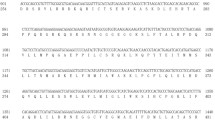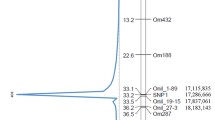Abstract
Estrogens are essential for many reproductive and non-reproductive functions. In teleosts, it is well-known that several subtypes of estrogen receptors are required for the precise action of estrogens. Present study describes the cloning of the third estrogen receptor, ER- β2, from the Nile tilapia by EST sequencing coupled microarray. The cloned ER-β2 showed 77.7% amino acid identity with the reported Atlantic croaker ER-β. Three ERs, ER-α, ER-β1 and ER-β2, from the fugu genome were also isolated to analyze their gene structures. Comparison of the intron/exon boundaries and exon numbers of fugu, tilapia, rainbow trout and zebrafish, and phylogenetic analysis of 63 ER sequences revealed that ER-β probably underwent two successive lineage-specific duplications in teleost. The former took place only in zebrafish lineage, and the latter took place in advanced teleosts without the zebrafish lineage, whereas no duplication of the ER-α gene has been detected. Tissue distribution analysis by RT-PCR revealed that tilapia ER-α and ER-β1 were expressed ubiquitously, whereas ER-β2 is expressed only in the pituitary, liver, intestine, kidney and gonads, with the highest expression in the testis and the lowest level in the ovary. Northern blot analysis detected a single transcript of about 3.4 kb in the testis but not in the ovary mRNAs. In transient transfection assays using human embryonic kidney 293 (HEK293) cells, tilapia ER-β2 showed estrodiol-17β dependent transactivation.
Similar content being viewed by others
References
Amores A, Force A, Yan YL, Joly L, Amemiya C, Fritz A, Ho RK, Langeland J, Prince V, Wang YL, Westerfield M, Ekker M, Postlethwait JH (1998) Zebrafish hox clusters and vertebrate genome evolution. Science 282:1711–1714
Bardet PL, Horard B, Robinson-Rechavi M, Laudet V, Vanacker JM (2002) Characterization of oestrogen receptors in zebrafish (Danio rerio). J Mol Endocrinol 28:153–163
Chang XT, Kobayashi T, Todo T, Ikeuchi T, Yoshiura Y, Kobayashi HK, Morrey C, Nagahama Y (1999) Molecular cloning of estrogen receptors α and β in the ovary of a teleost fish, the tilapia (Oreochromis niloticus). Zool Sci 16:653–658
Filardo EJ, Quinn JA, Frackelton AR Jr, Bland KI (2002) Estrogen action via the G protein-coupled receptor, GPR30: stimulation of adenylyl cyclase and cAMP-mediated attenuation of the epidermal growth factor receptor-to-MAPK signaling axis. Mol Endocrinol 16:70–84
Green S, Walter P, Kumar V, Krust A, Bornert JM, Argos P, Chambon P (1986) Human estrogen receptor cDNA: sequence, expression and homology to v-erbA. Nature 320:134–139
Greene GL, Gilna P, Waterfield M, Baker A, Hort Y, Shine J (1986) Sequence and expression of human estrogen receptor complementary DNA. Science 231:1150–1154
Hawkins MB, Thornton JW, Crews D, Skipper JK, Dotte A, Thomas P (2000) Identification of a third distinct estrogen receptor and reclassification of estrogen receptors in teleosts. Proc Natl Acad Sci USA 97:10751–10756
Hawkins MB, Thomas P (2004) The unusual binding properties of the third distinct teleost estrogen receptor subtype ER β are accompanied by highly conserved amino acid changes in the ligand binding domain. Endocrinology 145:2968–2977
Hirata S, Shoda T, Kato J, Hoshi K (2002) Novel isoforms of the mRNA for human female sex steroid hormone receptors. J Steroid Biochem Mol Biol 83:25–30
Kozak M (1986) Point mutations define a sequence flanking the AUG initiator codon that modulates translation by eukaryotic ribosomes. Cell 44:283–292
Kuiper GGJM, Enmark E, Pelto-Huikko M, Nilsson S, Gustafsson JA (1996) Cloning of a novel estrogen receptor expressed in rat prostate and ovary. Proc Natl Acad Sci USA 93:5925–5930
Kuiper GGJM, Shughrue PJ, Pelto-Huikko M, Merchenthaler I, Gustafsson JA (1998) The estrogen receptor β subtype: a novel mediator of estrogen action in neuroendocrine systems. Front Neuroendocrinol 19:253–286
Lassiter CS, Kelley B, Linney E (2002) Genomic structure and embryonic expression of estrogen receptor βa (ER βa) in zebrafish (Danio rerio). Gene 299:141–151
Le Roux MG, Theze N, Wolff J, Le Pennec JP (1993) Organisation of a rainbow trout estrogen receptor gene. Biochim Biophys Acta 1172:226–230
Ma CH, Dong KW, Yu KL (2000) cDNA cloning and expression of a novel estrogen receptor β-subtype in goldfish (Carassius auratus). Biochim Biophys Acta 1490:145–152
Manglesdorf DJ, Thummel C, Beato M, Herrlich P, Schutz G, Umesono K, Blumberg B, Kast-ner P, Mark M, Chambon P, Evans RM (1995) The nuclear receptor superfamily: the second decade. Cell 83:835–839
Menuet A, Pellegrini E, Anglade I, Blaise O, Laudet V, Kah O, Pakdel F (2002) Molecular characterization of three estrogen receptor forms in zebrafish: binding characteristics, transactivation properties, and tissue distributions. Biol Reprod 66:1881–1892
Menuet A, Le Page Y, Torres O, Kern L, Kah O, Pakdel F (2004) Analysis of the estrogen regulation of the zebrafish estrogen receptor (ER) reveals distinct effects of ER β1 and ER β2. J Mol Endocrinol 32: 975–986
Meyer A, Schartl M (1999) Gene and genome duplications in vertebrates: the one-to-four (-to-eight in fish) rule and the evolution of novel gene functions. Curr Opin Cell Biol 11:699–704
Mosselman S, Polman J, Dijkema R (1996) ER β: identification and characterization of a novel human estrogen receptor. FEBS Lett 392:49–53
Ohno S (1993) Patterns in genome evolution. Curr Opin Genet Dev 3:911–914
Ponglikitmongkol M, Green S, Chambon P (1988) Genomic organization of the human oestrogen receptor gene. EMBO J 7:3385–3388
Razandi M, Pedram A, Greene GL, Levin ER (1999) Cell membrane and nuclear estrogen receptors (ERs) originate from a single transcript: studies of ER α and ER β expressed in Chinese hamster ovary cells. Mol Endocrinol 13:307–319
Robinson-Rechavi M, Marchand O, Escriva H, Bardet PL, Zelus D, Hughes S, Laudet V (2001a) Euteleost fish genomes are characterized by expansion of gene families. Genom Res 11:781–788
Robinson-Rechavi M, Marchand O, Escriva H, Laudet V (2001b) An ancestral whole-genome duplication may not have been responsible for the abundance of duplicated fish genes. Curr Biol 11:R458–459
Sabo-Attwood T, Kroll KJ, Denslow ND (2004) Differential expression of largemouth bass (Micropterus salmoides) estrogen receptor isotypes α, β, and γ by estradiol. Mol Cell Endocrinol 218:107–118
Swope D, Harrell JC, Mahato D, Korach KS (2002) Genomic structure and identification of a truncated variant message of the mouse estrogen receptor alpha gene. Gene 294:239–247
Tan NS, Lam TJ, Ding JL (1996) The first contiguous estrogen receptor gene from a fish, Oreochromis aureus: evidence for multiple transcripts. Mol Cell Endocrinol 120:177–192
Thompson JD, Gibson TJ, Plewniak F, Jeanmougin F, Higgins DG (1997) The ClustalX windows interface: flexible strategies for multiple sequence alignment aided by quality analysis tools. Nucleic Acids Res 24:4876–4882
Todo T, Adachi S, Yamauchi K (1996) Molecular cloning and characterisation of Japanese eel estrogen receptor cDNA. Mol Cell Endocrinol 119:37–45
Van de Peer Y, Taylor JS, Meyer A (2003) Are all fishes ancient polyploids? J Struct Funct Genom 3:65–73
Author information
Authors and Affiliations
Corresponding author
Additional information
D. S. Wang and B. Senthilkumaran contributed equally.
Rights and permissions
About this article
Cite this article
Wang, D.S., Senthilkumaran, B., Sudhakumari, C.C. et al. Molecular cloning, gene expression and characterization of the third estrogen receptor of the Nile tilapia, Oreochromis niloticus . Fish Physiol Biochem 31, 255–266 (2005). https://doi.org/10.1007/s10695-006-0033-2
Issue Date:
DOI: https://doi.org/10.1007/s10695-006-0033-2




